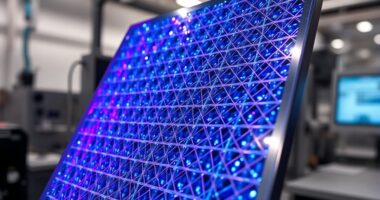Fluorescence microscopy is a powerful technique that allows you to view the inner workings of cells in vibrant detail. By using special dyes called fluorophores, you can target specific cellular components, making them glow under advanced microscopes. This method highlights structures and processes that are otherwise invisible, revealing dynamics within living cells. If you keep exploring, you’ll discover how ongoing innovations are expanding our ability to see even the tiniest cellular features.
Key Takeaways
- Fluorescence microscopy uses specific fluorophores to label cellular components, enabling targeted and detailed visualization of cell structures.
- Advanced techniques like confocal and super-resolution microscopy improve image clarity and reveal cellular details beyond the diffraction limit.
- Fluorophore development focuses on brightness, stability, and diverse colors to facilitate multi-component cellular imaging.
- Live-cell imaging with stable fluorophores allows real-time observation of dynamic processes within cells.
- Combining innovative fluorophores with sophisticated microscopy methods enhances our understanding of cellular architecture and functions.

Have you ever wondered how scientists observe tiny structures within cells? The answer lies in the fascinating world of fluorescence microscopy, a technique that uses light to reveal the hidden details of biological specimens. At the core of this method is fluorophore development, where scientists design and refine molecules that emit specific wavelengths of light when excited. These fluorophores are essential because they attach to particular cell components, making them glow under the right lighting conditions. The development process involves understanding how these molecules absorb and emit light, ensuring they are bright, stable, and specific to their targets. Advances in fluorophore development have expanded the palette of colors available, allowing researchers to label multiple structures simultaneously and study their interactions in real time.
Once the fluorophores are ready, microscopy techniques come into play. Unlike traditional light microscopes, fluorescence microscopes use special filters and light sources to excite the fluorophores and detect their emitted light. This setup isolates the signals from the background, producing crisp images of cellular structures. Techniques such as confocal microscopy take this a step further by using point illumination and pinholes to eliminate out-of-focus light. This results in sharper images with increased resolution and the ability to create three-dimensional reconstructions of cells. Other methods like total internal reflection fluorescence (TIRF) microscopy focus on the cell membrane, providing detailed views of processes happening at the cell surface.
Fluorescence microscopes use special filters and light sources for high-resolution, three-dimensional cellular imaging.
The power of fluorescence microscopy is amplified by these advanced microscopy techniques, which allow you to observe dynamic processes within living cells. You can track the movement of proteins, monitor changes in cellular environments, and even visualize interactions between molecules. The development of new fluorophores and improvements in microscopy hardware continue to push the boundaries of what you can see. For example, super-resolution microscopy techniques like STED and PALM break the diffraction limit of light, revealing structures at a nanometer scale that were once invisible. Additionally, fluorophore stability is crucial for long-term imaging experiments, enabling scientists to observe cellular processes over extended periods without losing signal quality.
In essence, fluorescence microscopy combines the art of fluorophore development with innovative microscopy techniques to illuminate the cell’s inner workings. It transforms invisible cellular details into vibrant, accessible images, giving you a window into the microscopic universe. Through this powerful tool, scientists can explore complex biological processes with unprecedented clarity, advancing our understanding of life at the cellular level. Whether you’re studying disease mechanisms or simply exploring the beauty of cellular architecture, fluorescence microscopy offers a fascinating way to see the unseen.
Frequently Asked Questions
How Does Fluorescence Microscopy Compare to Electron Microscopy?
You’ll find that fluorescence microscopy offers excellent contrast by using fluorescent labels to highlight specific cell components, making it easier to identify structures. However, it doesn’t provide the electron detail that electron microscopy delivers, which reveals ultra-fine cellular details at a much higher resolution. So, if you need contrast to locate molecules, fluorescence is ideal; but for detailed structural analysis, electron microscopy is your best choice.
What Are Common Challenges in Live-Cell Fluorescence Imaging?
Imagine peering into a glowing, living world, but you face hurdles like photobleaching artifacts that fade your signals or autofluorescence interference that clouds your view. These common challenges in live-cell fluorescence imaging can distort your observations and limit clarity. You must carefully balance illumination intensity and duration, select ideal fluorophores, and manage background signals to maintain cell vitality and guarantee accurate, vibrant imaging.
Can Fluorescence Microscopy Be Used for Quantitative Analysis?
Yes, fluorescence microscopy can be used for quantitative measurement. You can perform fluorescence quantification to analyze the intensity of signals, which reflects the amount of target molecules or structures within cells. To guarantee accurate results, you need to calibrate your system, account for background noise, and maintain consistent imaging conditions. This approach allows you to precisely measure changes in fluorescence, providing valuable insights into cellular processes.
What Are Recent Advancements in Fluorescence Probe Technology?
Recent advancements in fluorescence probe technology include new probe designs that enhance specificity and brightness, making it easier for you to detect subtle cellular changes. Photoactivatable dyes allow you to control when and where fluorescence occurs, enabling precise imaging of dynamic processes. These innovations improve resolution and reduce background noise, empowering you to explore cellular mechanisms with greater detail and accuracy in your fluorescence microscopy studies.
How Is Fluorescence Microscopy Integrated With Other Imaging Techniques?
You can combine fluorescence microscopy with other imaging techniques like MRI or electron microscopy to create powerful multimodal imaging. This integration, using fluorescent tagging, allows you to visualize cellular processes in unprecedented detail across different scales. It’s like upgrading from a flashlight to a full-spectrum spotlight, revealing both the big picture and tiny details simultaneously. By merging these methods, you gain access to a new level of understanding in biological research.
Conclusion
As you explore fluorescence microscopy, picture it as lighting up the hidden city within your cells. Each glowing structure becomes a vibrant street, revealing secrets once cloaked in darkness. This technique transforms the invisible into a radiant map, guiding your understanding through a luminous maze. With each flicker of fluorescence, you uncover the cell’s story, turning the microscopic into a dazzling rescue mission where light becomes your most powerful tool.









